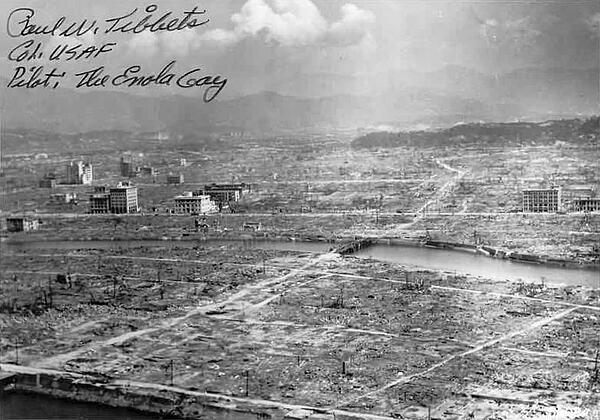Hiroshima
Hiroshima was the target of the first of two nuclear bombs dropped in Japan by the United States. The bomb was dropped on Hiroshima on 6 August 1945, killing around 15,000 people and devastating the city. The event - which remains controversial - was one of two uses of nuclear bombs in history. The other was at Nagaski, three days after the bombing of Hiroshima.
The ‘Little boy’ bomb, which was 2,000 times more powerful than the largest weapon used up to that point, created many fires which consumed Hiroshima and lasted for three days, trapping and killing many of the survivors of the initial blast. Many more died of the long-term effects of radiation sickness.
The purpose of the bombing of Hiroshima and Nagasaki was to end the war as quickly as possible with the fewest US casualties. On 25 July 1945, an order was issued calling for the first atomic bomb to be dropped on one of the following cities: Hiroshima, Kokura, Niigata, and Nagasaki. The order naming Hiroshima as the primary target was issued on 2 August. The city was chosen because it was an important military base and one of the few cities not to have an allied POW camp.

The bomb was carried by the Enola Gay, which was piloted by Colonel Paul Tibbets. It took off from North Field, Tinian, on the morning of 6 August and was accompanied by two other B-29s. Receiving the report that the sky over the primary target was clear, the Enola Gay headed straight for Hiroshima. The target was the T-shaped Aioi Bridge in the central part of the city. At 8:15 a.m. on 6 August the atomic bomb was dropped and detonated approximately 600 meters over the Shima Hospital, located about 300 meters southeast of the Aioi Bridge.
Only three of the 12 people on board the Enola Gay actually knew the real purpose of their mission to Hiroshima. One of the men in the plane was British pilot Leonard Cheshire, who later described the mushroom cloud created by the bomb:
“Obscene in its greedy clawing at the earth, swelling as if with its regurgitation of all the life that it had consumed.”
The bomb flattened five square miles of Hiroshima and destroyed 60 per cent of its buildings. The blast was accompanied by a fireball which radiated white heat reaching temperatures of between 3,000 and 4,000 degrees celsius. The intense heat caused those at the bomb’s impact point to simply incinerate and left many thousands more with fatal burns.
Doctors and nurses did all they could to treat victims of the bombing, but medical supplies were in critical short supply. To make matters worse, more than 90 per cent of the doctors and 93 per cent of the nurses in Hiroshima were killed or injured as most had been in the downtown area which received the greatest damage.
Tens of thousands of civilians suffered from radiation poisoning. Known as ‘A-bomb disease’, exposure to radiation could cause symptoms that mimicked dysentery. For decades after, people living in Hiroshima suffered illnesses caused by radiation exposure.
Three days after the bombing of Hiroshima, the United States dropped a second, bigger atomic bomb on the city of Nagaski. The weapon known as "Fat man", after Winston Churchill, weighed nearly 4,050 kg (nearly 9,000lb). The bomb killed between 40,000 and 80,000 civilians.
President Harry Truman announced the news of the bombing from the cruiser, USS Augusta, in the mid-Atlantic. He said:
“It is an atomic bomb. It is a harnessing of the basic power of the universe. The force from which the sun draws its power has been loosed against those who brought war to the Far East.”
See also: Enola Gay and Hiroshima
Blog Post: "My God, What Have We Done?": The Hiroshima Bombing 70 Years On
MLA Citation/Reference
"Hiroshima". HistoryLearning.com. 2026. Web.
